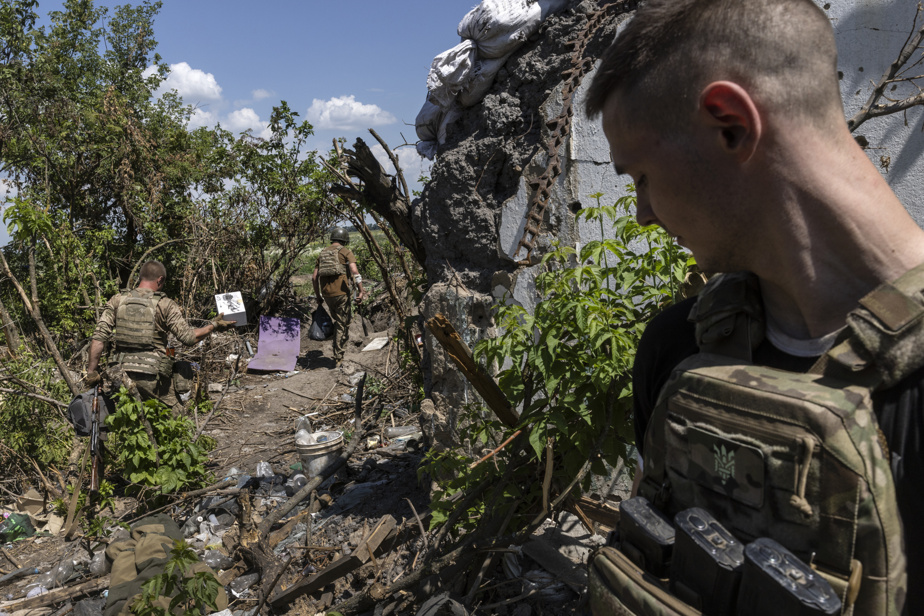(Novodarivka, Ukraine) A bottle of syrup made from Siberian berries, legions of dirty socks and a bag of military tea with the inscription “For Victory”.
For Ukrainian soldiers, one of the advantages of the counter-offensive launched a month ago in southern Ukraine is that they can appropriate the fortifications already built by the retreating Russians, who dug deep and well-protected trenches during months of preparations.
For the Ukrainians, strangely, this also means that they have to live and fight on positions long held by the Russians, with a lot of military debris and personal belongings of Russian soldiers strewn all over the place.

PHOTO DAVID GUTTENFELDER, THE NEW YORK TIMES
In an abandoned house, Russian soldiers carved into the plaster of the walls the names of their cities or regions of origin: Vladikavkaz, a city in southern Russia, and Primorye, a region on the Pacific coast, near Japan.
“It’s not very pleasant,” says Private Maksim, a member of 36e Ukrainian Marine Brigade, which has collected a number of curiosities, including what it believes to be a talisman: several balls covered in sequins and attached to a key chain.
“It’s our land, but it’s not very comfortable to be here,” said the soldier who, like the other soldiers, only gave his first name and rank for security reasons. “We don’t feel at home. »
In early June, Ukrainian troops, including thousands trained and equipped by the United States and other Western allies, launched a counteroffensive aimed at driving a wedge into Russian-occupied southern Ukraine. Lying in wait, thousands of Russian soldiers are stationed in miles of trenches and other fortifications, amid tank traps and thousands upon thousands of mines.

PHOTO DAVID GUTTENFELDER, THE NEW YORK TIMES
Russian tank destroyed and abandoned in Novodarivka
Ukrainian forces attack at least three places on the Russian defensive front. At the furthest point of advance, they pushed south to form a bulge about 8 km inside the defense lines.
Ukrainian commanders want to reach the Sea of Azov, some 90 km away, across open plains that offer little cover. If successful, they will divide the Russian-occupied South into two areas, cutting the land bridge between Russia and the occupied Crimean Peninsula and severely compromising Russia’s ability to resupply its forces further west.
Abandonned
As they advanced, the Ukrainians seized Russian trench lines, bunkers and firing positions in abandoned buildings, but under continuous artillery bombardment they had little time to dispose of their enemy’s trash and abandoned clothing, body armor, ponchos, bedding and remnants of military rations.

PHOTO DAVID GUTTENFELDER, THE NEW YORK TIMES
The Russians left and the Ukrainians took over the trench, which does not change anything for this cat.
Maksim, interviewed in the trenches, had collected a small pile of curios left behind, including a berry syrup made in Yakutia, a region in northern Siberia. By showing the Russian tea brand “For Victory!” he says of his former Russian owner: “He didn’t have time to drink it. »
Take the example of the village of Novodarivka, located in the plains of the Zaporizhia region in southern Ukraine, south of the city of Orikhiv. A month after the soldiers of the 110e Territorial Defense Brigade of Ukraine and other units have taken it over, the village is still littered with rubbish from the occupying forces.
One of the most harrowing tasks was recovering the remains of Ukrainian soldiers who died defending the village during the early months of the war, as Russian forces rapidly advanced.
Seven bodies have been lying nearby since April 2022, said one of the soldiers, Lieutenant Volodymyr.

PHOTO DAVID GUTTENFELDER, THE NEW YORK TIMES
Ammunition and rubbish left by Russian soldiers in a trench near Novodarivka
The Ukrainians had sometimes flown drones over the village when it was occupied, to make sure the Russians had not moved the bodies. They were finally able to get them back. “They were just skeletons” that had to be identified by their DNA, Volodymyr said.
As for the Russian dead, he added, the Ukrainians collected those that could be safely removed and covered the rest with a pile of dirt in an attempt to limit the smell. Nevertheless, a foul stench wafts through the trenches and swarms of flies buzz everywhere.
Small advances
The 110e territorial defense brigade, unlike the newly trained and equipped units deployed specifically for the counteroffensive, has been fighting in southern Ukraine for more than a year.

PHOTO DAVID GUTTENFELDER, THE NEW YORK TIMES
Hiding in a trench in the Zaporizhia region, members of the 110e Territorial Defense Brigade fly drones to scout Russian positions.
A soldier of the 110ewho identified himself as Sergeant Igor, said his unit crawled to the relative safety of tree lines between fields to attack the Russian trenches, moving in small leaps of a few tens or hundreds meters at a time.
These slow advances are preferable to all-out assaults, the sergeant explained.
“We have to move forward bit by bit, with the infantry, and break them up in this way,” Igor said. “Crawl forward, fight them, then dig again. »
It takes time for the advancing Ukrainian soldiers, trained by Kyiv’s Western allies, to learn how to fight on open farmland.
Recruits are demoralized when their comrades are injured or killed, Igor explains. “Their morale is quickly affected,” he said.
“Soldiers will learn,” he added. It is complicated. And yes, things are moving slowly. But what is important is that it is progressing. »
This article was first published in the New York Times.
